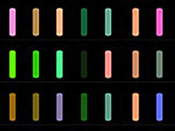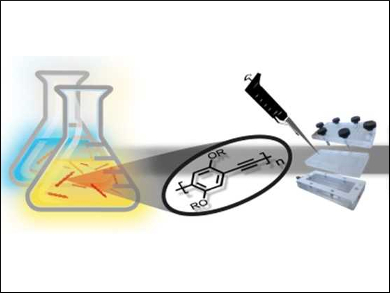So-called hypothesis-free sensor arrays use fluorescent dyes to distinguish a wide variety of complex analytes, for example, fruit juices or whiskeys. Water-soluble poly(aryleneethynylene)s (PAE)s are used for this analytical technique because they change fluorescence quantum yield and/or emission color with the pH value. Hypothesis-free sensor arrays can be immobilized on a solid support and offer a simple analytical process similar to pH strips.
Uwe Bunz and colleagues, University of Heidelberg, Germany, have used such strips to distinguish between different cola brands. The team used die-cast solutions of seven different fluorescent polyelectrolytes of the PAE-type. The PAEs are immobilized on a commercially available nylon membrane to produce indicator strips. The immobilized PAEs emit different colors under fluorescent light.
When the stripes are  exposed to different cola brands, the fluorescence intensity and color change of the exposed strips can be photographed by using a standard digital camera (three examples pictured left, one per row; colors enhanced). Each brand of cola gives a specific fluorescence- and color-change pattern. The signal generation is partially due to the pH differences and partially due to the caramel color and other ingredients such as sweeteners and sugars that interact with the sensor strips by electrostatic or hydrophobic interactions.
exposed to different cola brands, the fluorescence intensity and color change of the exposed strips can be photographed by using a standard digital camera (three examples pictured left, one per row; colors enhanced). Each brand of cola gives a specific fluorescence- and color-change pattern. The signal generation is partially due to the pH differences and partially due to the caramel color and other ingredients such as sweeteners and sugars that interact with the sensor strips by electrostatic or hydrophobic interactions.
Simpler strips with only three elements can be used as reversible pH sensors. Overall, the immobilization of the PAEs and the use of a simple camera is a significant step towards more practical applications of PAE-based arrays in hypothesis-free sensor applications.
- Immobilized Poly(aryleneethynylene) pH Strips Discriminate Different Brands of Cola,
Markus Bender, N. Maximilian Bojanowski, Kai Seehafer, Uwe H. F. Bunz,
Chem. Eur. J. 2018.
https://doi.org/10.1002/chem.201803103



